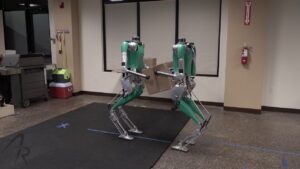
Artificial intelligence (AI) refers to the simulation of human intelligence in machines that are programmed to think and act like humans. These intelligent machines can be designed to perform tasks that typically require human intelligence, such as learning, decision making, and problem solving.
There are various types of AI, including:
-
Rule-based AI: This type of AI follows a set of pre-defined rules to solve problems or make decisions.
-
Machine learning: This type of AI involves the use of algorithms to enable machines to learn and adapt on their own, without being explicitly programmed.
-
Neural networks: This type of AI is inspired by the way the human brain works, and involves the use of interconnected nodes to process and analyze data.
-
Natural language processing: This type of AI enables machines to understand and generate human language, allowing them to communicate with humans in a more natural way.
AI has the potential to revolutionize a wide range of industries, including healthcare, finance, transportation, and education. However, the development and deployment of AI also raise ethical concerns, such as the potential for job displacement and the need to ensure that AI systems are fair and unbiased.
Advantages and Disadvantages of AI
Some potential advantages of artificial intelligence (AI) include:
-
Increased efficiency: AI can perform tasks faster and more accurately than humans, which can help businesses save time and reduce costs.
-
Improved decision-making: By analyzing large amounts of data, AI can help businesses make more informed decisions, leading to better outcomes.
-
Enhanced customer service: AI-powered chatbots and other customer service tools can provide quick and personalized assistance to customers, improving their experience.
-
New opportunities: The development and deployment of AI can create new job opportunities and industries.
However, there are also potential disadvantages to consider:
-
Job displacement: AI has the potential to automate tasks that are currently performed by humans, which could lead to job displacement.
-
Ethical concerns: AI systems can be biased if they are trained on biased data, and there are concerns about the ethical implications of decision-making by machines.
-
Security risks: AI systems can be vulnerable to cyber attacks, which could lead to data breaches and other security issues.
-
Lack of transparency: AI systems can be difficult to understand and interpret, making it difficult for people to understand how decisions are being made.
-
Cost: Developing and implementing AI systems can be expensive, and small businesses may struggle to afford the necessary investments.
Cost Savings: Artificial Intelligence
There are several ways that artificial intelligence (AI) can help businesses save costs:
-
Increased efficiency: By automating tasks and optimizing processes, AI can help businesses save time and reduce the need for labor, leading to cost savings.
-
Improved decision-making: By analyzing large amounts of data, AI can help businesses make more informed decisions, leading to cost savings through better resource allocation and improved outcomes.
-
Reduced errors: AI can help reduce the occurrence of errors, which can save businesses money by avoiding the costs associated with correcting mistakes.
-
Enhanced productivity: AI can help businesses operate more efficiently by allowing employees to focus on higher-value tasks, increasing overall productivity and leading to cost savings.
-
Improved supply chain management: AI can help businesses optimize their supply chain operations, leading to cost savings through more efficient use of resources and better management of inventory and transportation.
-
Enhanced customer service: AI-powered chatbots and other customer service tools can provide quick and personalized assistance to customers, improving their experience and potentially leading to increased customer loyalty and sales.
- SEO Powered Content & PR Distribution. Get Amplified Today.
- PlatoData.Network Vertical Generative Ai. Empower Yourself. Access Here.
- PlatoAiStream. Web3 Intelligence. Knowledge Amplified. Access Here.
- PlatoESG. Automotive / EVs, Carbon, CleanTech, Energy, Environment, Solar, Waste Management. Access Here.
- PlatoHealth. Biotech and Clinical Trials Intelligence. Access Here.
- ChartPrime. Elevate your Trading Game with ChartPrime. Access Here.
- BlockOffsets. Modernizing Environmental Offset Ownership. Access Here.
- Source: https://www.supplychaintoday.com/artificial-intelligence-resources-and-information/
- :has
- :is
- 1
- 11
- 7
- a
- About
- accurately
- Act
- adapt
- advantages
- AI
- AI systems
- AI-powered
- algorithms
- allocation
- Allowing
- also
- amounts
- analyze
- analyzing
- and
- ARE
- artificial
- artificial intelligence
- Artificial intelligence (AI)
- AS
- Assistance
- associated
- Attacks
- automate
- automating
- avoiding
- BE
- being
- Better
- biased
- Brain
- breaches
- businesses
- by
- CAN
- chain
- chatbots
- communicate
- Concerns
- Consider
- Cost
- cost savings
- Costs
- could
- create
- Currently
- customer
- Customer Loyalty
- Customer Service
- Customers
- cyber
- Cyber Attacks
- data
- Data Breaches
- decision
- Decision Making
- decisions
- deployment
- designed
- developing
- Development
- difficult
- Education
- efficiency
- efficient
- efficiently
- employees
- enable
- enables
- ensure
- Errors
- ethical
- expensive
- experience
- fair
- faster
- finance
- Focus
- follows
- For
- generate
- healthcare
- help
- How
- However
- HTTPS
- human
- human intelligence
- Humans
- if
- implementing
- implications
- improved
- improving
- in
- include
- includes
- Including
- increased
- increasing
- industries
- informed
- inspired
- Intelligence
- Intelligent
- interconnected
- inventory
- Investments
- issues
- IT
- Job
- Job Opportunities
- jpg
- labor
- language
- large
- lead
- leading
- LEARN
- learning
- like
- Loyalty
- Machines
- made
- make
- Making
- management
- May..
- mistakes
- money
- more
- more efficient
- Natural
- necessary
- Need
- networks
- New
- nodes
- of
- on
- operate
- Operations
- opportunities
- Optimize
- optimizing
- or
- Other
- outcomes
- overall
- own
- People
- perform
- performed
- Personalized
- plato
- Plato Data Intelligence
- PlatoData
- potential
- potentially
- Problem
- problems
- process
- processes
- processing
- productivity
- programmed
- provide
- Quick
- raise
- range
- reduce
- refers
- require
- resource
- Resources
- revolutionize
- risks
- rules
- sales
- Save
- Savings
- security
- service
- set
- several
- simulation
- small
- small businesses
- SOLVE
- Solving
- Struggle
- such
- supply
- supply chain
- supply chain management
- Systems
- tasks
- than
- that
- The
- their
- Them
- There.
- These
- they
- think
- this
- Through
- time
- to
- tools
- trained
- Transparency
- transportation
- type
- types
- typically
- understand
- use
- various
- Vulnerable
- Way..
- ways
- What
- What is
- which
- wide
- Wide range
- with
- without
- works
- zephyrnet













